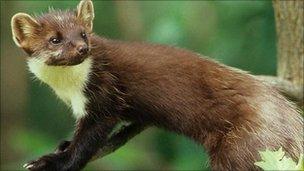Welsh place names hold key to the past, say experts
- Published
Ask anyone from outside Wales to name something for which we're famous, and the odds are that the name of Llanfairpwllgwyngyllgogerychwyrndrobwllllantysiliogogogoch on Anglesey would rank in their top five.

Wales is well known for the very lengthy place name of Llanfair PG on Anglesey
But what's really in a place name?
Should Beddau in Rhondda Cynon Taf be pronounced "Bather", as many of the locals do, or "Beth-eye" according to its roots in Welsh?
A group of geographical and historical experts from around Wales say Welsh place names are particularly important, as they tend to be descriptive of the conditions at the time of naming, whereas English place-names are subject to obscure influences from Latin, German, French and Scandinavian languages.
Despite the rich source of information which they could hold, Wales does not have a national place-name body monitoring trends and derivations, as does Scotland, England and Northern Ireland.
Yet a conference this weekend, organised by The Snowdonia National Park, Cymdeithas Edward Llwyd and the Welsh Assembly Government is aiming to change that, by drawing together historians, geographers and linguists to form Wales' own place name society.
Twm Elias of Snowdonia's Plas Tan y Bwlch study centre, has helped organise the Llên Natur conference, and explained:
"It's not so much how people pronounce place-names today, it's about recording how locations have been named, written and pronounced over time."
"People who live in Beddau are welcome to call it 'Bather' or 'Beth-eye' as they choose; it's their town after all! But if we forget that the town's name comes from Beddau, the Welsh for graves, then we'd be losing an understanding of its possible roots as an ancient, pre-Christian burial site."
But whilst the true meaning of Beddau's name is not fully understood, many other historical, socio-economic, and environmental riddles have been solved through the study of how our ancestors named their lands.
Through the name of Dôl-y-Pennau in Snowdonia ( which translates into "Meadow of Heads"), members of the Llên Natur project were able to point archaeologists to the previously-undiscovered site of a massacre between feuding Welsh princes, which resulted in dozens of people being beheaded before their heads were discarded in a field in the area named in their memory.
A study of a concentration in eastern Wales, of places bearing the suffix 'Wern' or 'Gwern' has similarly lent fresh understanding to the trade links between medieval Wales and the Norman Marcher states.
Gwern derives from the Welsh for alder tree, the willow-like wood from which was used to manufacture clogs for agricultural workers.
While the trees are native throughout Wales, the frequency of Wern and Gwern in the east of the country pointed historians towards studying potential sites where they may have been grown on a commercial basis, for sale to agricultural areas over the border in Herefordshire and Shropshire.

A number of place names in Wales include 'bela'- Welsh for pine marten
But not all the discoveries are of a purely historical nature.
The pine marten, a small mammal once native to Wales, is now facing extinction.
However, the number of places which include 'bela' - Welsh for pine marten - in their name is testament to the frequency with which they were once found here.
Conservationists are using these places as a starting point to study satellite imagery for potential sites where pine martens may one day be re-introduced into the wild.
This weekend's conference is the culmination of years of work by Duncan Brown, a Welsh-speaker whose work for the Countryside Council for Wales led to his fascination with the links between language and environment.
But he warned: "It's sometimes dangerous to read too much into place names, or to take them too literally."
"For example, places with 'eos' suffixes derive from the Welsh for nightingale. They're no longer native to Wales, and there's some debate whether they ever were.
"Yet there are two clusters of 'eos' names in Wales, one around Carmarthenshire and Glamorganshire, and another in the north, centred around Denbighshire and northern Powys."
"The south Wales group are prefixed with terms like 'llwyn', a copse, or 'y-pant' , a hollow, which correspond with the natural habitat of nightingales."
"However, the group in the north have prefixes like 'llety'r', from the Welsh for a tavern or inn.
"So the reference to nightingale is far more likely to have originated from someone who sung there, with the voice of a nightingale."
Message of importance
The Llên Natur conference is being opened with an address by Culture Minister Alun Ffred Jones.
Mr Brown is hoping this will prove indicative of more concrete support for the project.
"It's fantastic to have Alun Ffred along to speak anyway, as it's a real recognition of the hard work everyone has put in," he said.
"Everyone knows that there's not much money to go around at the moment, but inexpensive things could make a big difference."
"We've already made a huge start on a database of place-names and their origins on the Llên Natur website, and with access to support from the assembly (government) we could go even further."
"Also, some within the group would like to see legislation brought before the assembly to prevent historic Welsh place names becoming anglicised or changed altogether to ones with no local significance."
"Even if the resources weren't available to police it rigorously, the simple presence of legislation would send out a message of the importance that Welsh place names continue to have to this day."